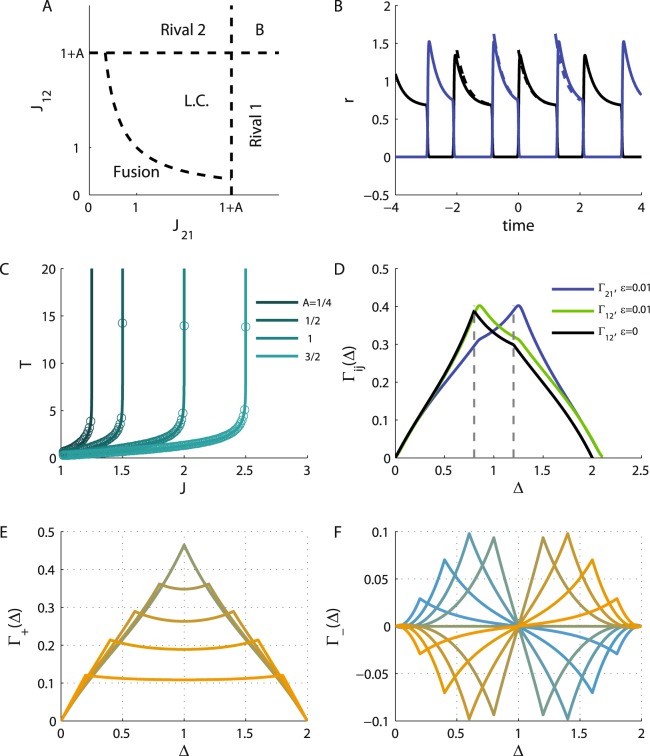Figure 1.
Neuronal dynamics. (A) The phase diagram. The regions of different types of solutions for the neuronal dynamics are depicted in the (quarter of the) plane of (non-negative) J21 and J12. (B). The limit cycle solution. The firing rate of populations 1 and 2 are plotted in black and blue, respectively, as a function of time (measured in units of τa) in the anti-phase oscillatory solution with T1 = 1.2 and T2 = 0.8, yielding J21 ≈ 2.36 and J12 ≈ 1.87 (see Eq. (43)). In this specific example we used I = 2, A = 2, the solid lines show the solution for and the dashed depict the solution in the limit of . (C) The oscillation period along the diagonal. The oscillation period on the diagonal is shown as a function of the reciprocal inhibition strength for different values of the adaptation strength, A = 0.25, 0.5, 1, 1.5 from left to right. Solid lines show the analytical relation of Eq. (44) in the limit. The circles depict the case. (D) The cross-correlation function. The neuronal cross-correlations Γ12 (green and black) and Γ21 (blue) are plotted as a function of the time difference, Δ (measured in units of the adaptation time constant τa). The black line depicts the correlations in the limit, whereas the green and blue lines show the case. Parameters were identical to B. For the case the correlations were evaluated from the numerical solution for the dynamics. (E) The ‘mean cross-correlation’ function. The mean correlation, Γ+, in the limit of , (see subsection Calculation of the cross-correlation function in Methods) is plotted as a function of Δ for T = 2 and different values of the T1 = T[0.1, 0.2, … 0.9] shown by color. Note that the plots for T1 = x and T1 = T − x overlap. (F) The ‘difference cross-correlation’. The difference in the cross-correlation, Γ−, in the limit of , is plotted as a function of Δ for T = 2 and different values of the T1 = T × {0.1, 0.2, … 0.9} shown by color from yellow (T1 = 0.1T) to blue (T1 = 0.9T). In E and F A = 2 and I = 2 were used.

